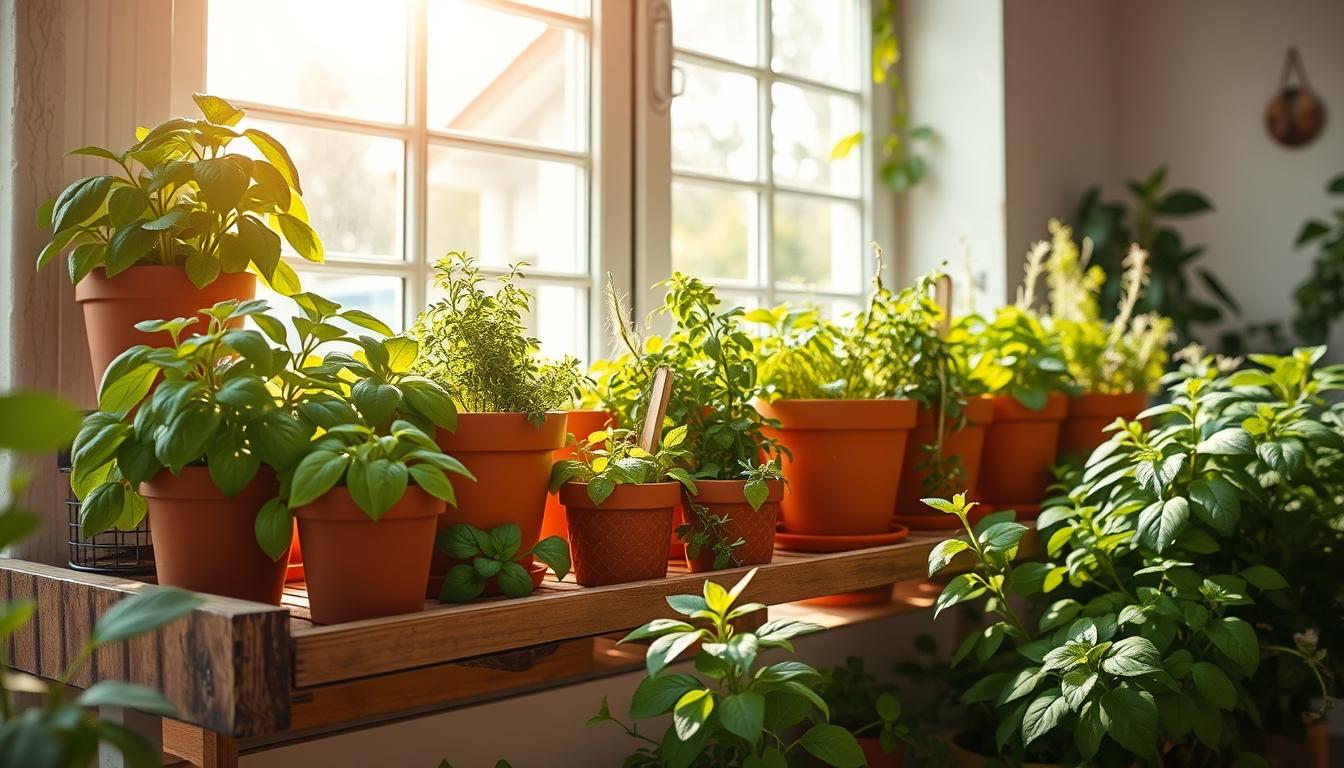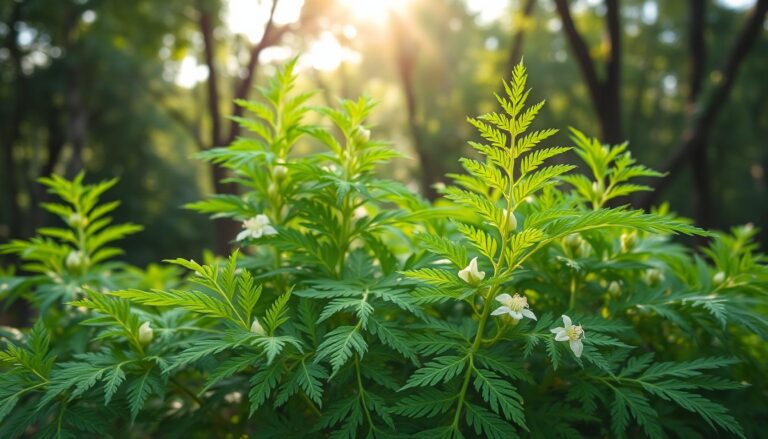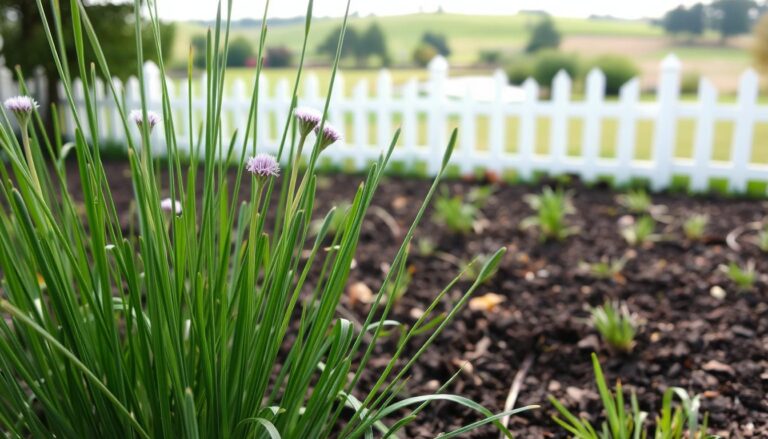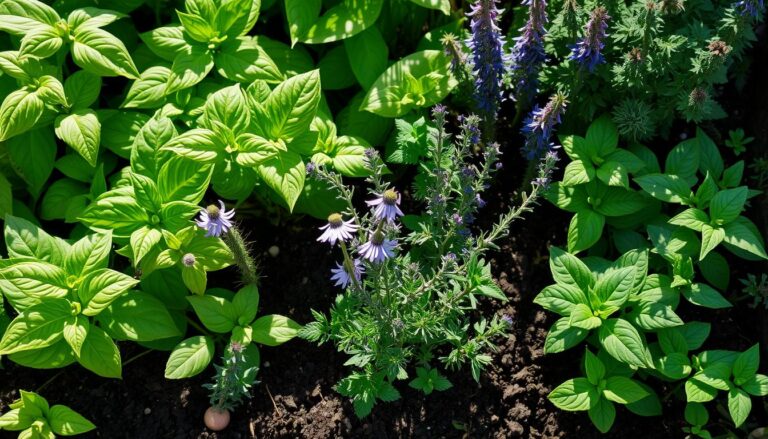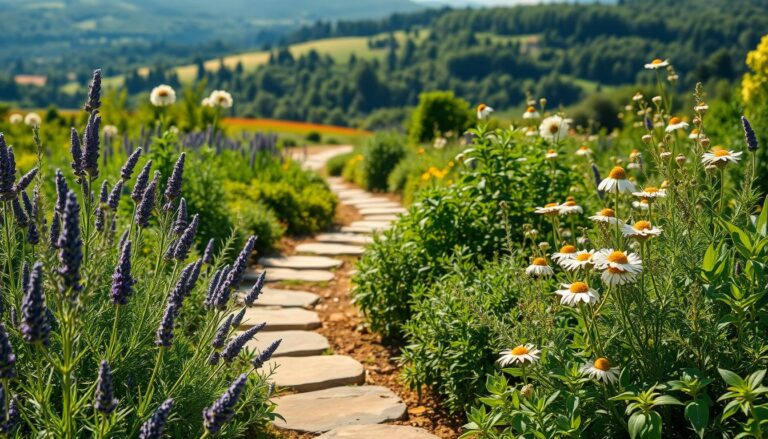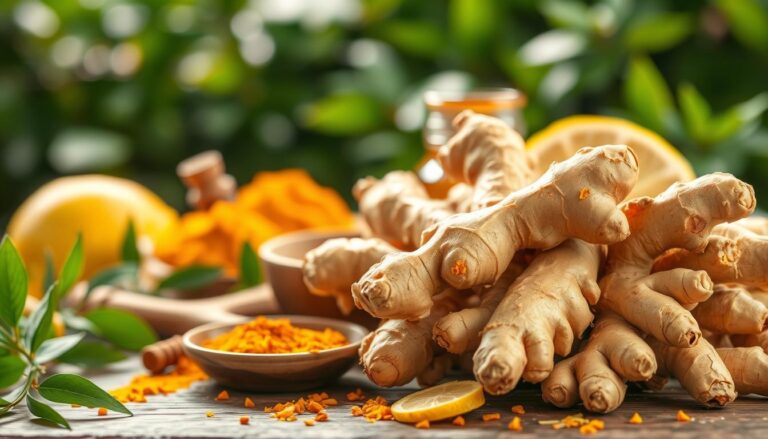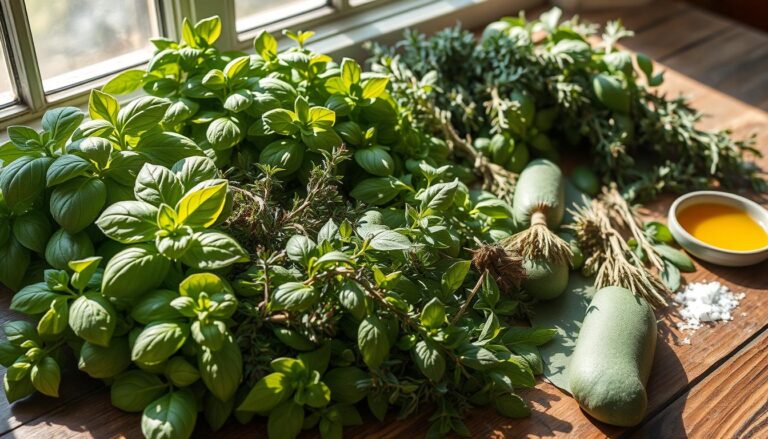Grow Herbs Indoors All Year: 10 Best Indoor Herbs
Imagine having fresh parsley, basil, and thyme all year. You won’t need a backyard garden for it.
Growing a kitchen garden indoors is easy. Just use a sunny windowsill. You can grow many indoor herbs to make your cooking better and your home fresher.

Many herbs do well indoors with the right care. This article will show you the best indoor herbs to grow indoors. You’ll also learn how to take care of them.
Key Takeaways
- Discover the top 10 indoor herbs perfect for indoor gardening.
- Learn the basics of indoor herb gardening and how to keep your herbs thriving.
- Understand the benefits of having a kitchen garden indoors.
- Find out how to choose the right herbs for your indoor garden.
- Get tips on caring for your indoor herbs to ensure they flourish year-round.
The Benefits of Growing Herbs Indoors
Growing herbs indoors can make your cooking better, save money, and boost your health. An indoor herb garden brings many benefits. It improves your cooking and overall health.
Fresh Flavors Year-Round
Growing herbs indoors means you get fresh flavors all year. You don’t have to worry about the season or weather outside. This way, you can always have your favorite herbs for cooking.
Cost Savings Over Store-Bought Herbs
Having an indoor herb garden saves you money. You can pick what you need, cutting down on waste and buying less. It’s a smart way to save.
Health and Wellness Benefits
Indoor herb gardening is good for your health. It can reduce stress and improve the air you breathe. It’s a simple way to add green to your home and improve your health.
Aesthetic Appeal and Air Purification
Indoor herb gardens also make your home look better. They add beauty and help purify the air. They brighten up any room and make your home feel more welcoming.
Setting Up Your Indoor Herb Garden
Starting an indoor herb garden is exciting. It needs the right setup and care to thrive. You’ll need to think about a few key things to make your garden a success.
Choosing the Right Location
Finding the perfect spot for your herbs is important. Most herbs need lots of light to grow well. A south-facing window is best, but east or west windows work too if they get direct sunlight for 4-6 hours a day.
Tip: If your space doesn’t get enough natural light, use grow lights. This ensures your herbs get the light they need.
Container Options for Indoor Herbs
Choose containers that let water drain well to avoid soggy soil. You can pick from clay, ceramic, or plastic pots. Make sure they’re clean and have holes for drainage.

Soil and Drainage Requirements
Herbs like well-draining soil to avoid root rot. Use a mix made for indoor plants or herbs. Or, mix potting soil with perlite and vermiculite to create your own.
Starting from Seeds vs. Seedlings
Whether to start with seeds or seedlings depends on the herb. Some, like basil and cilantro, are easy from seeds. Others might be harder.
| Herb | Start from Seeds? | Start from Seedlings? |
|---|---|---|
| Basil | Yes | Yes |
| Cilantro | Yes | No |
| Rosemary | Yes | Yes |
By thinking about these points and making smart choices, you can create a thriving indoor herb garden. It will give you fresh herbs all year.
Essential Light Requirements for Indoor Herbs
Indoor herbs need enough light to grow well. Knowing how much light they need is key. Most herbs need at least six hours of direct sunlight a day.
Natural Light Considerations
Herbs do best near a south-facing window. This spot gets the most natural light. But, the light’s strength can change with the seasons and outside obstructions.
Supplemental Lighting Options
If there’s not enough natural light, you can use extra lights. LED grow lights are a good choice. They use less energy and help plants grow well.
- LED grow lights
- Fluorescent lights
- High-Intensity Discharge (HID) lights
Light Duration and Intensity
How long and how bright the light is matters a lot. Most herbs need 12-14 hours of light daily. Changing the light’s intensity and time can really help your herbs.
Seasonal Light Adjustments
As seasons change, so does the light for indoor herbs. In winter, extra lights might be needed. In summer, herbs might need shade to avoid burning.
By knowing and adjusting to your herbs’ light needs, you can grow them all year. This makes indoor gardening even better.
Herbs That Grow Indoors All Year: Key Success Factors
To grow herbs indoors all year, knowing the key elements is crucial. The right conditions are essential for their growth.
Temperature and Humidity Needs
Most herbs like daytime temperatures between 65-75°F (18-24°C). At night, they prefer temperatures around 55-65°F (13-18°C). Humidity should be between 40-60%. Proper temperature and humidity are crucial for healthy herb growth.
Watering Practices for Indoor Herbs
Don’t overwater your indoor herbs. Check the soil moisture by inserting a finger into the soil up to the first knuckle. Water only when the soil feels dry. Herbs like basil and mint require more frequent watering.
Fertilizing Schedule and Requirements
Indoor herbs need regular fertilization. Use a balanced, water-soluble fertilizer (20-20-20) during the growing season. Dilute the fertilizer to half the recommended strength to avoid burning the roots.
Air Circulation and Ventilation
Good air circulation is essential for preventing fungal diseases and promoting healthy growth. Ensure that your indoor herb garden has adequate ventilation.
“Air circulation is key to a thriving indoor garden,” says Jane Smith, a renowned indoor gardening expert.
| Herb | Temperature (°F) | Humidity (%) |
|---|---|---|
| Basil | 65-75 | 40-60 |
| Mint | 60-70 | 50-70 |
| Rosemary | 65-75 | 40-50 |

Basil: The Kitchen Essential
Basil is a top choice for indoor herbs because of its taste and easy growth. Growing it indoors means you always have fresh basil for cooking.
Varieties Best Suited for Indoor Growing
Many basil types grow well indoors. Genovese basil is loved for its sweet taste and smell. Thai Basil and Lemon Basil also do great indoors, adding special flavors to food.

Light and Water Requirements
Basil needs lots of light to grow indoors. Place it near a sunny window or under grow lights. It’s also key to water it often but not too much, to avoid root rot.
Common Problems and Solutions
Yellow leaves on basil can mean too much water. Pests can also be a problem. Check your basil often and keep the air moving. Use natural pest control to keep your plant safe.
Harvesting and Culinary Uses
Harvesting basil often helps it grow bushy and prevents it from flowering. Cut off flower buds and trim long stems. Basil is great in pasta sauces, salads, Thai curries, and pesto.
By following these tips, you can have a healthy basil plant indoors. This will make your cooking even better with fresh basil leaves.
Mint: The Prolific Grower
Mint is a hardy herb that thrives indoors with proper care. Its fast growth makes it a favorite for indoor herb plants.
Varieties That Thrive Indoors
Peppermint, spearmint, and chocolate mint are great for indoors. They’re hardy and fit well in indoor spaces, making them top perennial indoor herbs.

Light and Water Requirements
Mint likes partial shade to full sun and needs consistent moisture. Good indoor herb care means keeping the soil moist but not too wet to avoid root rot.
Containing Mint’s Vigorous Growth
To keep mint from spreading too much, grow it in containers. This stops its roots from taking over other plants, a key part of indoor herb care.
Harvesting and Culinary Uses
Mint leaves can be picked as needed. Just pinch or cut off the leaves for use in teas, cocktails, salads, and desserts. This shows how versatile indoor herb plants can be.
Rosemary: The Aromatic Perennial
Indoor herb gardening is very rewarding, and rosemary is a top choice. This herb has a piney smell and is key in Mediterranean cooking.
Varieties Best Suited for Indoor Growing
‘Tuscan Blue’ and ‘Arp’ are great for indoor rosemary. ‘Tuscan Blue’ grows upright and smells strong. ‘Arp’ is good for cold places and does well indoors.
Light and Water Requirements
Rosemary needs bright, indirect light to grow well indoors. Direct sun can burn the leaves. A south-facing window with a curtain is best. Water it carefully, as it likes dry soil to avoid root rot.
| Lighting Condition | Watering Frequency | Soil Preference |
|---|---|---|
| Bright, indirect light | When top inch of soil feels dry | Well-draining |
Common Problems and Solutions
Yellow leaves on indoor rosemary often mean too much water. Pests can also be a problem. Good air flow and regular checks can help solve these issues.
Harvesting and Culinary Uses
Harvest rosemary by pinching off the top leaves. This encourages it to grow bushy. It’s great in roasted meats, veggies, and breads, adding flavor and aroma.
Thyme and Oregano: Mediterranean Favorites
Thyme and oregano are two herbs from the Mediterranean that grow well indoors. They need the right conditions to thrive. These herbs are key in many cuisines, especially in Mediterranean cooking. They add depth and warmth to dishes.
Varieties That Thrive Indoors
For thyme, English thyme and French thyme grow well indoors because they don’t spread out much. Oregano like Greek oregano is also good for indoor growing. It’s hardy and has a great flavor.
Light and Water Requirements
Thyme and oregano need bright, indirect light to grow well. They should be watered carefully because they like well-draining soil. Too much water can cause root rot. So, always check the soil before watering.
Common Problems and Solutions
A common problem is leggy growth from not enough light. Pruning them regularly helps. It keeps them bushy and promotes healthy growth.
Harvesting and Culinary Uses
Harvesting these herbs often encourages new growth. Thyme is perfect in soups and stews. Oregano is essential in Mediterranean dishes like pizza and pasta sauces. Growing them indoors means you always have fresh herbs. This boosts your cooking with year-round indoor herbs and proper indoor herb care.
Chives and Parsley: The Kitchen Staples
Chives and parsley are top picks for indoor herbs. They bring convenience and flavor to your kitchen. These herbs add fresh taste to many dishes.
Best Varieties for Indoor Growing
The most common chive variety for indoor growing is Allium schoenoprasum. It’s hardy and has an onion-like taste. For parsley, the curly-leaf variety (Petroselinum crispum) is best. It grows well indoors and is versatile.
Light and Water Requirements
Chives and parsley need enough light to grow well. Chives can handle some shade, but parsley likes direct sunlight. Keep the soil moist but not too wet. Good drainage is key to avoid root rot.
Common Problems and Solutions
Indoor chives and parsley often get leggy from too little light. Move them to brighter spots or use grow lights. Regular trimming helps them grow bushy.
Harvesting and Culinary Uses
Harvesting these herbs is simple. Just cut off what you need with scissors. Chives add a mild onion taste, while parsley is great as a garnish or in salads and sauces.
“Gardening is a love story between you and your plants, and cooking is the poetry that comes from it.”
Using fresh chives and parsley in your cooking can make your dishes better.
Cilantro and Dill: The Challenging Herbs
Cilantro and dill are popular herbs that can be hard to grow indoors. They need specific conditions to thrive. Yet, many gardeners indoors successfully grow these herbs for their taste and beauty.
Strategies for Indoor Success
To grow cilantro and dill indoors, mimic their natural growing conditions. This means using the right soil, enough light, and the right watering. Starting with high-quality seeds and containers that drain well can help a lot.
Light and Water Requirements
Cilantro and dill need bright, indirect light to do well indoors. A sunny window or grow lights can help. Water them regularly but carefully, as they can get root rot if the soil is too wet. Checking the soil moisture often can stop overwatering.
Preventing Bolting
Bolting, or plants going to seed too early, is a common problem with cilantro and dill indoors. To avoid this, keep the temperature steady and ensure they get enough light without getting too hot. Regularly picking the leaves can also help them grow bushy instead of flowering.
Harvesting and Culinary Uses
Cilantro and dill are harvested in different ways. Cilantro leaves are usually picked fresh. Dill can be harvested for its leaves, seeds, or flowers. Both herbs add fresh flavors to many dishes, like salads, soups, sauces, and marinades.
Sage and Lemon Balm: Aromatic Perennials
Sage and lemon balm are great for indoor growing. They add flavor to food and a nice smell to your home.
Best Varieties for Indoor Growing
For sage, ‘Tricolor’ and ‘Purpurascens’ are good choices. They look nice and taste great. Lemon balm, being a mint, is hardy. ‘Aurea’ and ‘All Gold’ have pretty leaves that brighten up your space.
- Sage ‘Tricolor’: Known for its leaves with white, green, and purple variegation.
- Lemon Balm ‘All Gold’: Features bright yellow leaves that retain their color throughout the growing season.
Light and Water Requirements
Both herbs need lots of light. Sage likes full sun to partial shade. Lemon balm does well in bright, indirect light. Water them right; sage likes dry soil, while lemon balm prefers moist but not soggy.
Common Problems and Solutions
Sage might drop leaves if you water too much. It can also get leggy without enough light. Lemon balm can get waterlogged and rot. Prune them often to keep them healthy and looking good.
- Overwatering: Check soil moisture before watering.
- Insufficient Light: Consider using grow lights to supplement natural light.
Harvesting and Uses
Harvest these herbs often to make them grow more. Sage is great in savory dishes. Lemon balm is good in teas and desserts. They also help with health; sage boosts brain function, and lemon balm calms you down.
By following these tips, you can enjoy these herbs all year. They’ll make your cooking better and your home smell nice.
Conclusion: Enjoying Your Year-Round Indoor Herb Garden
Growing herbs indoors all year can be very rewarding. It gives you a steady supply of fresh flavors for your meals. With the right care, your indoor herb garden can thrive, saving you money, looking great, and being good for your health.
Choosing the right herbs like basil, mint, and rosemary is key. Following the tips in this article will help you enjoy your indoor herb garden all year. Make sure to give them the right light, water, and food to keep them healthy and growing.
Indoor herb gardening can make cooking better and add some green to your home. As you learn more about growing herbs indoors, you’ll love picking fresh herbs right in your own space, no matter the season.
FAQ
What are the best herbs to grow indoors year-round?
The top herbs for indoor growing are basil, mint, and rosemary. Thyme, oregano, and chives are also great. Parsley, cilantro, dill, sage, and lemon balm round out the list. These herbs are easy to care for and do well indoors.
How much light do indoor herbs need?
Indoor herbs need bright, indirect light to grow. Some, like basil and rosemary, need more light. Others, like mint and parsley, can handle partial shade. You can also use LED grow lights to help.
How often should I water my indoor herbs?
Watering frequency depends on the herb, soil, and environment. Most herbs like well-draining soil and should be watered when the top inch is dry. Too much water can cause root rot, while too little can stress the plants.
Can I grow herbs indoors during the winter months?
Yes, many herbs can thrive indoors all year, including winter. Indoor gardens provide a stable environment, helping herbs grow well no matter the season.
How do I fertilize my indoor herbs?
Indoor herbs need regular fertilization for growth. Use a balanced, water-soluble fertilizer. Follow the instructions for how often and how much to use.
What are some common problems when growing herbs indoors?
Common issues include overwatering, underwatering, pests, and diseases. Regular checks and care can help avoid or fix these problems.
Can I grow herbs indoors in low-light conditions?
While most herbs need bright light, some like mint and parsley can handle low light. However, they might not grow as well or produce as much.
How do I prune and harvest my indoor herbs?
Pruning and harvesting encourage bushy growth and more leaves. Regular trimming helps keep the plants healthy and looking good.
Can I grow multiple herbs together in the same container?
Yes, you can grow several herbs together in one container. Just make sure they have similar needs and get along. This can make for a lively indoor garden.
How do I prevent pests in my indoor herb garden?
Prevent pests by regularly checking your plants and keeping the area clean. Good air flow and a clean space help. Isolate new plants and use organic pest control if needed.

